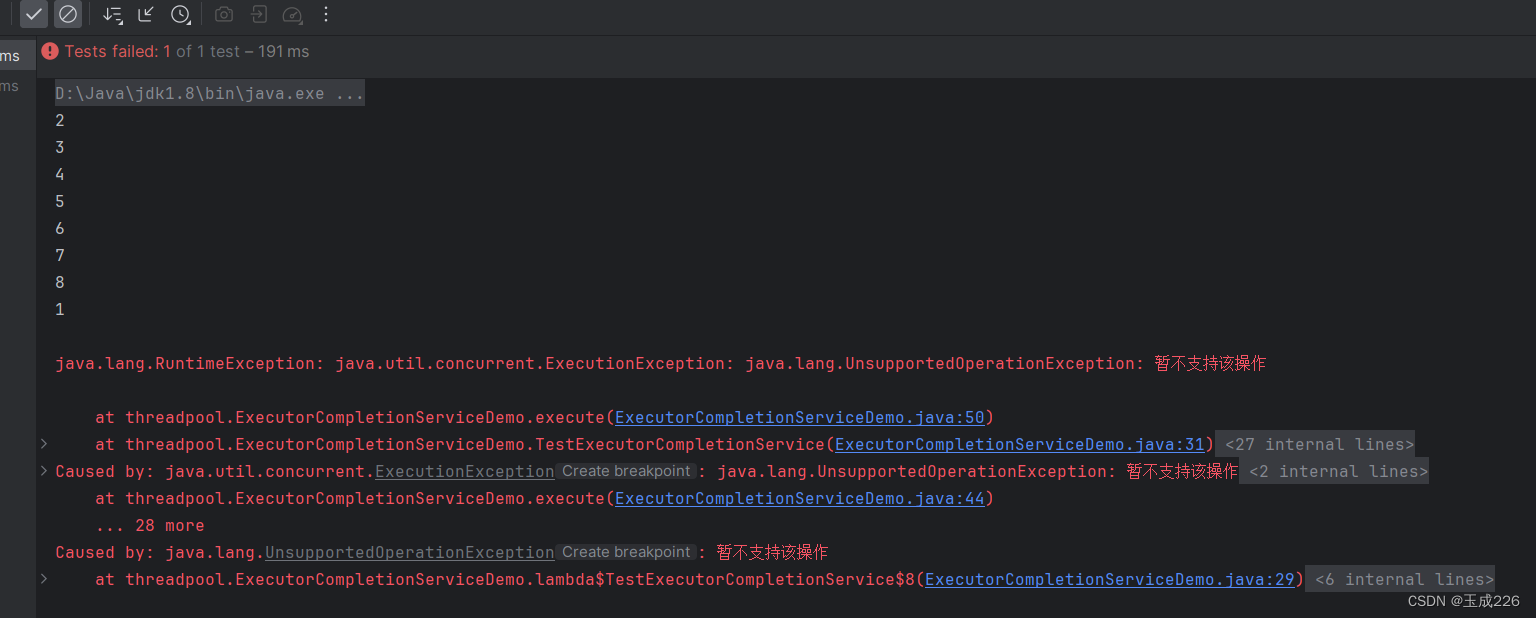一、什么是ExecutionException
在并发编程中在执行java.util.concurrent.Future实现类的get方法时,需要捕获java.util.concurrent.ExecutionException这个异常。Future.get()方法通常是要获取任务的执行结果,当执行任务的过程中抛出了异常,就会产生ExecutionException异常。
二、如何处理ExecutionException
案例分析:
package threadpool;import org.junit.Test;import java.util.ArrayList;
import java.util.Collection;
import java.util.List;
import java.util.concurrent.*;
public class ExecutorCompletionServiceDemo {@Testpublic void TestExecutorCompletionService () throws InterruptedException {ThreadPoolExecutor executor = new ThreadPoolExecutor(10, 20, 1, TimeUnit.SECONDS, new ArrayBlockingQueue<>(50));Collection<Callable<String>> tasks = new ArrayList<>();tasks.add(() -> {return "1";});tasks.add(() -> {return "2";});tasks.add(() -> {return "3";});tasks.add(() -> {return "4";});tasks.add(() -> {return "5";});tasks.add(() -> {return "6";});tasks.add(() -> {return "7";});tasks.add(() -> {return "8";});tasks.add(() -> {throw new UnsupportedOperationException("暂不支持该操作");});tasks.add(() -> {throw new NullPointerException("NullPointerException occurred");});execute(executor, tasks);}private static void execute(ThreadPoolExecutor executor, Collection<Callable<String>> tasks) {CompletionService<String> completionService = new ExecutorCompletionService<>(executor);List<Future<String>> futures = new ArrayList<>(tasks.size());for (Callable<String> task : tasks) {futures.add(completionService.submit(task));}for (int i = 0; i < futures.size(); i++) {try {Future<String> take = completionService.take();String s = take.get();System.out.println(s);} catch (InterruptedException e) {Thread.currentThread().interrupt();throw new RuntimeException(e);} catch (ExecutionException e) {throw new RuntimeException(e);}}}
}
在execute方法中对于对ExecutionExcetion异常可以做一下处理:
引入依赖:
<dependency><groupId>com.google.guava</groupId><artifactId>guava</artifactId><version>21.0</version></dependency>
private static void execute(ThreadPoolExecutor executor, Collection<Callable<String>> tasks) {CompletionService<String> completionService = new ExecutorCompletionService<>(executor);List<Future<String>> futures = new ArrayList<>(tasks.size());for (Callable<String> task : tasks) {futures.add(completionService.submit(task));}for (int i = 0; i < futures.size(); i++) {try {Future<String> take = completionService.take();String s = take.get();System.out.println(s);} catch (InterruptedException e) {Thread.currentThread().interrupt();throw new RuntimeException(e);} catch (ExecutionException e) {Throwable cause = e.getCause() == null ? e : e.getCause();Throwables.propagateIfPossible(cause, RuntimeException.class);throw new RuntimeException(cause);}}}

可以看出异常信息清晰了很多,便于开发人员分析。在上面的代码中通过getCause方法获取了来获取真实的异常。接下来使用了Google Guava提供的Throwable类来进行错误的转播与检查,当异常类型为RunTimeException进行抛出,最后使用Throw new RuntimeException(cause)进行兜底。
)




(认识,卸载与安装,JDK相关设置,详细设置,工程与模块管理,代码模板的使用))


与源码解读)
)







便捷的双向绑定数据)

